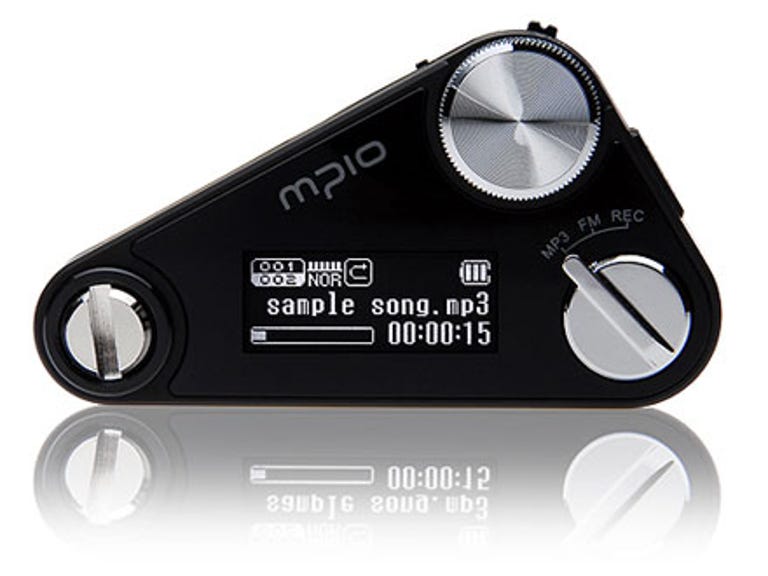 Why You Can Trust CNET
Why You Can Trust CNET MPIO FL500 (512MB) review: MPIO FL500 (512MB)
The FL500 offers analog style for the digital generation, but its keys, knobs and dials failed to push our buttons.
Design
A few manufacturers have railed against the distinctly digital look of late -- old-school Tivoli radios and rotary handsets that plug into itty bitty mobiles are but two examples. MPIO's FL500 is another device whose looks tend towards the analog. A very lightweight (23 grams), triangular player with rounded corners (the form factor was apparently inspired by the contours of an electric guitar), the FL500's retro looks set it apart from your average flash-based MP3 player.
The Good
The Bad
The Bottom Line
Instead of clickwheels and touchpads, the FL500 sports two mechanical silver dials. Spinning the top dial controls the volume level, while the bottom selector flicks between MP3, FM radio and recording modes. On the back of the player is a large silver belt clip, which can be removed by undoing the oversized silver screw on the front. Ditching the belt clip leaves you with a circular hole, through which you can thread a lanyard if you fancy the "MP3 player as accessory" look doing the rounds in schoolyards nowadays (or so we hear, anyway).
A three-line (128 x 48 pixel) monochrome display materialises upon powering up the player, and keeps you informed of the current track title, EQ, play mode, time and battery level, as well as a moving "visualisation" of the left and right sound bars -- the same as you'll find on your average vintage stereo. A hold switch, menu button, play/pause/skip rocker and mini USB port feature on the sides of the FL500, arranged in a manner that lacks logic or consistency, but at the very least looks unobtrusive.
Although the FL500 has a small footprint, you will probably need to use two hands when navigating through your song list, as the triangular shape makes the player a little too unwieldy for single-handed operation. The buttons and dials can be frustrating, especially the rocker that controls menu movement and song playback -- it is small, prone to occasional misbehaviour, and leaves an indent on your fingertip.
The small display caused the same problems we had with the mobiBLU Cube2 -- not being able to view more than three tracks in your library at one time is a lamentable restriction, and having to wait for titles to scroll across the screen in order to find out what you're listening to is also cause for irritation. (In fairness, you can adjust the scrolling speed so that the text zooms across the screen, but we'd still prefer our info to be displayed in its entirety.)
One non-negotiable design-related complaint: the earbuds. Use another pair, because those supplied are just no good. The buds were too big for our ears, and they've obviously been made on the cheap.
Features
The FL500's features list reads like that of most other flash players, with an FM tuner, voice and radio recording, and support for MP3, WMA and ASF file formats. Its plug-and-play, "no software required" status should please seasoned drag-and-droppers -- both Mac owners, and Windows users who may have had a traumatic Media Player experience and vowed to live a life of simplicity.
There are also a few options for tinkering with your tunes, including custom EQ, fade in, playback speed adjustment and auto sleep.
Performance
Provided you ditch the plasticky earbuds, the sound that emerges from the FL500 is none too shabby. Volume level doesn't reach very lofty heights, but should be loud enough to provide enough aural pleasure (unless you work on a construction site).
Our main issue was with the various buttons, switches and dials -- using the teeny rocker switch for menu navigation became tiresome, and the Menu key's operations defied intuition. We even found ourselves resorting to the user manual a few times, which, in this age of "rip box open, plug in, enjoy", was a little surprising.
One theoretical advantage of having a teeny monochrome screen is that it doesn't suck the life force from the battery faster than a kid with a slurpee. With the FL500, we clocked around 14 hours between charges -- not terrible, but recent players from Apple and Samsung have hovered around the 20-hour mark.
The FL500 is best suited to those who want to turn on, tune in and drop out; that is, people who will spend long stretches listening to the radio or a list of files without needing to press any buttons. The guitar-garnered styling is certainly different, but with a price approaching that of easy-use, higher capacity players, the FL500 may struggle to find a market.


